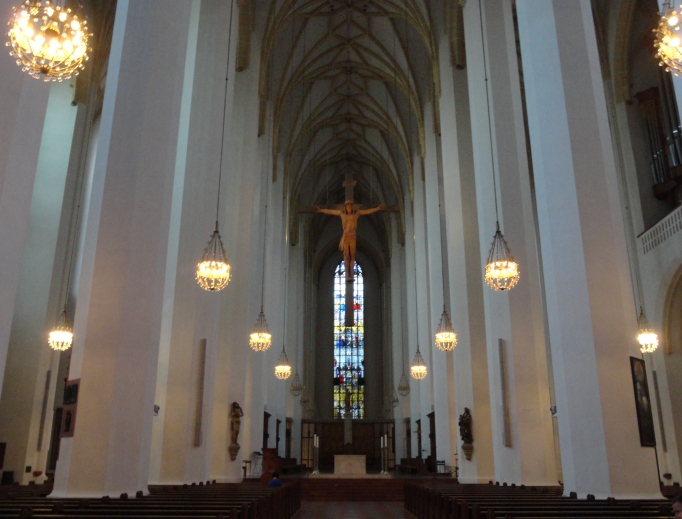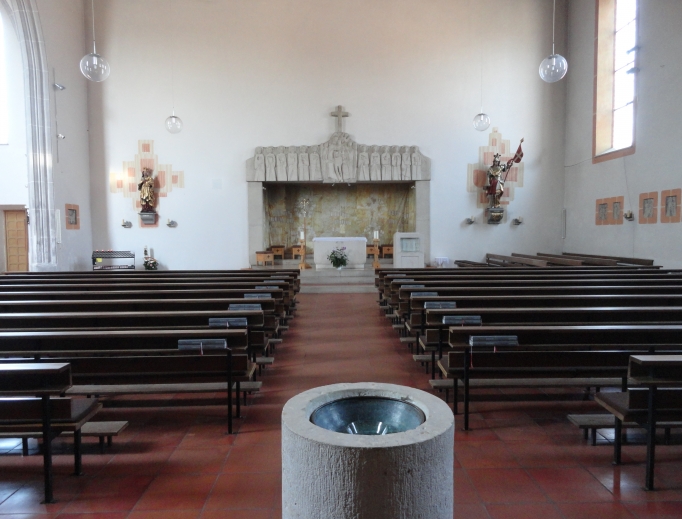A Visit to Benedict’s Bavaria
Germany’s Catholic Region Offers a Window Into Joseph Ratzinger

Bavaria’s Catholic heritage and proximity to the 20th century’s stormy history were pivotal in Pope Emeritus Benedict XVI’s vocation as priest, theologian and pope. Visiting the German region can help pilgrims better understand what shaped Joseph Ratzinger’s vision of the Church.
A trip to Bavaria usually begins in Munich, the largest city. Cardinal Joseph Ratzinger led the Archdiocese of Munich and Freising from 1977 to 1982. The onion dome-topped towers of the Frauenkirche cathedral dominate the Munich landscape. Inside the cathedral is a bas-relief depicting Benedict XVI. There, you can pay your respects to Cardinal Michael von Faulhaber, the late archbishop of Munich and Freising, who ordained Joseph Ratzinger and his brother Georg.

Marktl, the papal birthplace, is an hour and a half east of Munich. The house where the future pontiff was born is now a museum. Upon entry, one can view a short film on Benedict XVI’s life. The first floor summarizes Joseph Ratzinger’s life from his birth to his election to the throne of St. Peter. It displays memorabilia like the toy Mass chalices that Joseph and Georg played with as children.
The second floor displays a crozier and mitre that once belonged to Benedict. In addition, the exhibit explains the symbolism behind his papal coat of arms. The African Moor’s head on the left represents the universalism of the Church, and the bear carrying a pack on the right represents St. Corbinian, who evangelized Bavaria in the eighth century. According to legend, the saintly bishop instructed the bear to carry his belongings on his way to Rome and then released it into the wild, a symbol of how Christianity tamed the pagan ways of Bavaria. And the scallop shell is a reference to St. James the Apostle’s staff, a symbol of God’s pilgrim people.
Next to the museum is St. Oswald’s parish, where Joseph Ratzinger was baptized on the day he was born, on Holy Saturday 1927. The baptismal font in which he first became immersed in the Holy Spirit is now housed in the nearby Heimatmuseum.

Marktl is 10 miles from Altötting, the heart of Bavarian Catholicism. Altötting’s main square is named after Benedict XVI, who visited here in 2006. The seventh-century octagonal shrine in the center of the square houses the miraculous wooden figure of Our Lady. Devotion to this depiction of Mary began in the 15th century, when a child drowned and was brought back to life through Mary’s intercession. Mary still works miracles: Crutches and braces brought as votives by pilgrims healed through Our Lady of Altötting’s intercession line the shrine’s walls, much like in Lourdes or Czestochowa.
While Germany turned towards neo-pagan Nazism, Joseph Ratzinger’s parents presented an alternative, frequently bringing their children to Altötting. Benedict told his biographer Peter Seewald in Benedict XVI: An Intimate Portrait that the shrine is filled with “[t]he presence of something good, something saintly and healing, the Mother’s goodness, through which the goodness of God himself is shared with us.”
A somber part of a visit to Bavaria is Dachau, some 12 miles outside Munich. In 1934, shortly after Adolf Hitler had come to power, the first Nazi concentration camp was built here. Its original inmates were German political opponents of Nazism, but over time the camp’s prisoners came from across Europe; especially numerous were Jews, Poles, Soviet prisoners of war and Romani. Dachau’s prisoners were subjected to medical experiments, and at least 32,000 died.
Benedict XVI’s family suffered under Hitler. His father, Joseph Ratzinger Sr., was a policeman whose anti-Nazism caused his family to move several times.
And the future pope’s cousin who had Down syndrome was killed in the Third Reich’s euthanasia program. Joseph Ratzinger himself was conscripted into the auxiliary staff of the German air force, although he deserted near the end of the war, a brave act that could have cost him his life.
Walking the ground where so many innocent souls died at the hands of evil in Dachau is heartbreaking and haunting.
The museum exhibit highlights various groups persecuted in the camp. Prominent among them are Catholic priests, reflective of Hitler’s campaign against the Church. Some of the clergymen have since been beatified.
In The Priest Barracks: Dachau 1938-1945, Guillame Zeller writes that 2,720 priests were prisoners in the camp; 1,034 of them were martyred. Most priest inmates were Polish, although anti-Nazi German priests — including Michael Hock, the rector of the Munich seminary when Joseph and George Ratzinger were students — were the second-largest group.
Today, the former concentration camp houses a Catholic chapel that stands alongside a Lutheran church and Jewish memorial — an example of what Pope Francis would call “ecumenism of the blood” forged amidst shared persecution — as well as a Carmelite convent.
As the first Nazi camp, it was from Dachau that the genocidal cancer of the Third Reich metastasized. In a world again ravaged by armed conflicts, a visit there is not only a moving tribute to the camp’s victims; it is also a timely warning. The belongings of priest inmates on display, such as monstrances made of wood scrap, are an inspiring testimony to the tenacity of their faith amid torment, like that of the Christians thrown to the lions in ancient Rome and the many oppressed Christians in the Middle East, Africa and other regions today.
As someone fascinated by the thought of Benedict XVI, a visit to his homeland helped this writer better appreciate the deep cultural roots Catholicism has in Bavaria.
Today, Germany and many other Western countries are experiencing a crisis of faith. A visit to Bavaria offers tangible cultural Catholicism — which is felt when locals greet you with grüß Gott (“God bless”) or in the many beautiful churches that dominate Bavaria’s landscape — and a hope that, if even in the shadow of Nazism the vocation of such a brilliant theologian as Joseph Ratzinger could be born, then there is room for moral renewal.
Filip Mazurczak visited
Bavaria this summer.
He writes from New York.
- Keywords:
- bavaria
- benedict xvi
- filip mazurczak
- joseph ratzinger
- travel

















